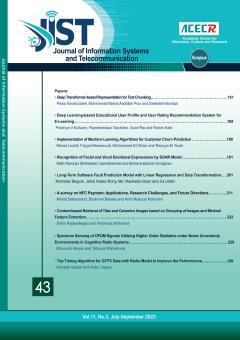-
-
List of Articles
-
Open Access Article
1 - Deep Transformer-based Representation for Text Chunking
Parsa Kavehzadeh Mohammad Mahdi Abdollah Pour Saeedeh Momtazi -
Open Access Article
2 - Deep Learning-based Educational User Profile and User Rating Recommendation System for E-Learning
Pradnya Vaibhav Kulkarni Sunil Rai Rajneeshkaur Sachdeo Rohini Kale -
Open Access Article
3 - Implementation of Machine Learning Algorithms for Customer Churn Prediction
Manal Loukili Fayçal Messaoudi Raouya El Youbi -
Open Access Article
4 - Recognition of Facial and Vocal Emotional Expressions by SOAR Model
Matin Ramzani Shahrestani Sara Motamed Mohammadreza Yamaghani -
Open Access Article
5 - Long-Term Software Fault Prediction Model with Linear Regression and Data Transformation
Momotaz Begum Jahid Hasan Rony Md. Rashedul Islam Jia Uddin -
Open Access Article
6 - A survey on NFC Payment: Applications, Research Challenges, and Future Directions
Mehdi Sattarivand Shahram Babaie Amir Masoud Rahmani -
Open Access Article
7 - Content-based Retrieval of Tiles and Ceramics Images based on Grouping of Images and Minimal Feature Extraction
Simin RajaeeNejad Farahnaz Mohanna -
Open Access Article
8 - Spectrum Sensing of OFDM Signals Utilizing Higher Order Statistics under Noise Uncertainty Environments in Cognitive Radio Systems
MOUSUMI HAQUE Tetsuya Shimamura -
Open Access Article
9 - Trip Timing Algorithm for GTFS Data with Redis Model to Improve the Performance
Mustafa Alzaidi Aniko Vagner
-
The rights to this website are owned by the Raimag Press Management System.
Copyright © 2017-2025







